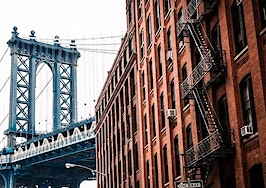- Community Board 7’s Landmarks Committee approved change of use and zoning proposals set forth by the owner, but the full community board flagged the project.
- The property owner, 361 Central Park west LLC, also went before NYC Board of Standards and Appeals to state five degrees of hardship for the site.
- Landmark West pointed out various inadequacies in the owner's argument of hardship. Letters from architects vouching for the upholding of the current landmark structure were included.
- Attorney Michael Hiller, who represents the Central Park West Neighbors Association, said a better use of land would be dedicated toward a private school or museum.
The former First Church of Christ, Scientist, in New York City’s Upper West Side is no longer slated for residential development after a year-long battle between the building’s owner and the Community Board 7’s Landmarks Committee.
In March of 2015, the Landmarks Preservation Commission approved the conversion of the former church into 39 condominiums. After plans were sent off the community board, CB7’s Land Use Committee approved change of use and zoning proposals set forth by the owner. However, the full community board flagged the project.
The property owner, 361 Central Park west LLC, also went before NYC Board of Standards and Appeals (SBA), which permits zoning variances for hardship, to state five degrees of hardship for the site — citing the physical conditions twice, including the narrowness of the lot; and third, that no exterior alterations that would modify the existing character of the building. The owner also stated that no hardships were requested due to the applicants wrongdoing. Finally, the owners stated that the modifications requested were the minimum necessary for returns on investments.
Prior to the hearing, Landmark West, the Committee to Preserve the Upper West Side, sent a letter to Chair Margery Perlmutter and Commissioners of the SBA. In addition to referencing the Landmarks Commissioners’ previous dissent, Landmark West pointed out various inadequacies in the owner’s argument of hardship in order to gain approval for exemption.
“The Applicant has offered no evidence that the Landmarks Preservation Commission would deny an alternative proposal that complied with zoning,” Landmark West wrote.

361 Central Park West/StreetEasy
“The Applicant was unwilling to change the proposal to accommodate a different program (for example, fewer apartments or non-residential use), claiming — again, without substantial evidence — that no other program was possible,” it stated.
Various letters from architects vouching for the integrity and upholding of the current landmark structure were included. Rather than eliminate the conversion completely, many recommended altering the designs to comply with the neighboring residents’ wishes.
“What the Commission can do is preserve the exterior of this New York City Designated Landmark. Doing so will not prevent the project from going forward, but it might require a design with fewer window[s], fewer rooms, or fewer apartments. I urge you to preserve the integrity of the street façade fenestration and massing of this significant building,” wrote Charles D. Warren, AIA and Co-Author of Carrère & Hasting Architects.
At the BSA hearing on Dec. 1, the Central Park West Neighbors Association were allowed to express concerns publicly. Attorney Michael Hiller represented the association, calling the hardship application “considerable hubris,” and stating the owners underestimated the value of the property, YIMBY reported. He also mentioned a better use of land would be dedicated toward a private school or museum.
In late February, final decisions regarding the former church site were still in the air. However, the developer reduced the number of units from 39 to 35. Now, residential plans have been resigned, and the fate for the corner of 96th Street and Central Park West are unknown.









